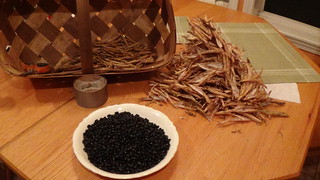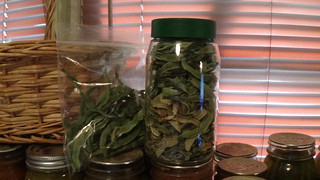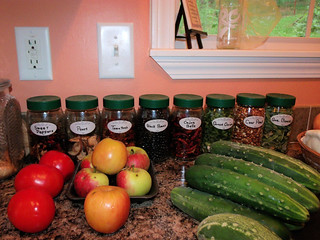My wife and I like making soups and stews with dried beans. Prior to putting in our own garden, we bought bags and bags of various dried beans and bean soup kits (assorted beans and seasoning in one bag). Black beans have always been a favorite of ours, so when I started gardening, I was sure to put in some black bean plants.
 When I think of dried beans, this is the sort of thing I think of. But recently I stumbled across a twist on the dried beans idea: dehydrated green beans. We dehydrate a lot of things: fruit slices, tomatoes, peppers, onions, and a wide variety of herbs, but green beans?
When I think of dried beans, this is the sort of thing I think of. But recently I stumbled across a twist on the dried beans idea: dehydrated green beans. We dehydrate a lot of things: fruit slices, tomatoes, peppers, onions, and a wide variety of herbs, but green beans?
My green beans are doing quite well this year and I have bunches of them blanched and frozen or canned for later use. And still they come in. So I decided to try drying a batch and see how that works out.
How to Make Dried Green Beans
Pick the beans when tender, wash them and trim off the stem tips and the tails. Cut them into manageable pieces. One note here: cut them into large manageable pieces; 3 inches or so, they will shrink up so much that 1” or 1½” pieces will end up small enough to fall through the grates in the dehydrator trays. Leave them long and break them later if you want. Arrange them in single layers in your trays.
Refer to the instructions for your dehydrator for times and temperatures. Mine is a basic machine; only one temperature so my main concern was to rotate the trays occasionally to even out the drying. My first batch took most of 3 days to dry in 7 or 8 hour long sessions each day.
I get paranoid about going off and leaving the dehydrator running unattended all night long, so if the run doesn’t finish in one session, I shut it off and set the trays in the freezer overnight. A fridge would work too, but the fridge in my office stays full, the freezer often has more space in it. And, ‘freeze-drying” actually seems to speed things as long as they got a good start before going into the freezer.
The second batch got forgotten until the wee-small hours of the morning when I awoke to the realization that I’d gone off and left it on. I wasn’t going to go stumbling around in the dark, rugged terrain to get to the other building to shut it off: if it hadn’t burned anything down by then it probably wouldn’t.
That batch ran all day and all night (about 22 hours) and was dry as toast.
Using Dried Green Beans
 We haven’t actually done this yet, but based on my experience with other dried vegetables (and statements made in the article I read) reconstituting the beans by soaking them in hot liquid will probably not produce anything you will want to spoon onto a plate as a side-dish for your dinner, but they should be quite good in soups and stews (just toss a hand-full into the stock) or in casseroles (soak in hot water first). It’s also possible that the dried beans can add a crunchy flavor to salads by using them as-is. Dehydrated tomato slices are good this way.
We haven’t actually done this yet, but based on my experience with other dried vegetables (and statements made in the article I read) reconstituting the beans by soaking them in hot liquid will probably not produce anything you will want to spoon onto a plate as a side-dish for your dinner, but they should be quite good in soups and stews (just toss a hand-full into the stock) or in casseroles (soak in hot water first). It’s also possible that the dried beans can add a crunchy flavor to salads by using them as-is. Dehydrated tomato slices are good this way.
 One of the advantages of drying the beans over freezing or canning is that you can store large quantities in a small space. I processed two 1 gallon bags of beans and ended up with a jar and a half of dried beans. Our storage jars are from our favorite iced tea mix. It comes in a reasonably attractive glass jar that holds about a pint. We have an array of these poor-man’s canisters on our kitchen counter to keep various dried foods at hand.
One of the advantages of drying the beans over freezing or canning is that you can store large quantities in a small space. I processed two 1 gallon bags of beans and ended up with a jar and a half of dried beans. Our storage jars are from our favorite iced tea mix. It comes in a reasonably attractive glass jar that holds about a pint. We have an array of these poor-man’s canisters on our kitchen counter to keep various dried foods at hand.
Another Dried Bean Twist
 Sometimes I don’t get the beans picked while they are as young as I’d like. The variety I’m growing this year is particularly susceptible to getting tough and stringy if left too long. We can boil the living daylights out of these older pods and they are still not pleasant to eat. What I’ve been doing with these is to open the pods and take out the beans inside for use in salads and cooking. I don’t care to save seed from these beans for next year, but it occurs to me that if I leave the pods that have matured too much on the plants to dry, like I do the black beans and pintos, these may well make a good dried white bean to add variety to our cooking. White bean chili is a favorite dish in our household. I’ll have to let you know how that works out, but I have high hopes. Have you tried it? If so, leave a note below and tell us of your experience.
Sometimes I don’t get the beans picked while they are as young as I’d like. The variety I’m growing this year is particularly susceptible to getting tough and stringy if left too long. We can boil the living daylights out of these older pods and they are still not pleasant to eat. What I’ve been doing with these is to open the pods and take out the beans inside for use in salads and cooking. I don’t care to save seed from these beans for next year, but it occurs to me that if I leave the pods that have matured too much on the plants to dry, like I do the black beans and pintos, these may well make a good dried white bean to add variety to our cooking. White bean chili is a favorite dish in our household. I’ll have to let you know how that works out, but I have high hopes. Have you tried it? If so, leave a note below and tell us of your experience.


You’re lucky to have such a magnificently producing garden, and room for a dehydrator, Allan. I bought dried white navy beans to soak and cook and mash to make vegetarian burgers with quinoa, chopped kale, a farm egg, some onion and spices. They were huge and moist, I cooked them on a grill and they browned nicely. You have to rub them with oil first so they don’t stick to the grill (don’t oil the grill, oil the patties). The recipe also provides for a sauce from yogurt, lemon juice, garlic, and other seasonings. I love farmer’s markets but I don’t enjoy gardening, anyhow. Too much work as a small child.
Thanks for the recipe and grilling tip, Kenna; I’ve tried oiling the grating on the grill – that does not work. We like vegi-burgers too and have tried several recipes. We think they taste great and using beans they have as much protein as meat, without the fat and bad-cholesterol.
When I was a kid, my dad continued his heritage of share-cropper by having a huge garden everywhere we went. I was slave labor. It was only about 4 years ago that I finally moved past my resentment for weeding, lil crawly things and dirty fingernails to embrace the joy of growing my own food. I’m glad, now, that I did but I completely understand your feelings about gardening.
Thanks for joining in, Kenna!